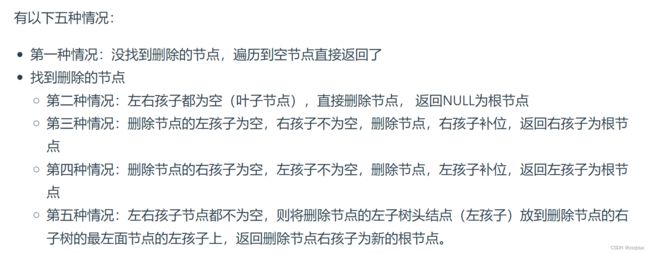代码随想录算法训练营Day22 | 235. 二叉搜索树的最近公共祖先,701.二叉搜索树中的插入操作,450.删除二叉搜索树中的节点
235. 二叉搜索树的最近公共祖先
文章链接 | 题目链接 | 视频链接
C++解法
/**
* Definition for a binary tree node.
* struct TreeNode {
* int val;
* TreeNode *left;
* TreeNode *right;
* TreeNode(int x) : val(x), left(NULL), right(NULL) {}
* };
*/
class Solution {
public:
TreeNode* lowestCommonAncestor(TreeNode* root, TreeNode* p, TreeNode* q) {
while (root != nullptr){
if (root->val > p->val && root->val > q->val){
root = root->left;
} else if (root->val < p->val && root->val < q->val){
root = root->right;
} else {
return root;
}
}
return root;
}
};Python解法
# Definition for a binary tree node.
# class TreeNode:
# def __init__(self, x):
# self.val = x
# self.left = None
# self.right = None
class Solution:
def lowestCommonAncestor(self, root: 'TreeNode', p: 'TreeNode', q: 'TreeNode') -> 'TreeNode':
if root is None:
return root
while root:
if root.val > p.val and root.val > q.val:
root = root.left
elif root.val < p.val and root.val < q.val:
root = root.right
else:
return root
return root701.二叉搜索树中的插入操作
文章链接 | 题目链接 | 视频链接
C++解法
/**
* Definition for a binary tree node.
* struct TreeNode {
* int val;
* TreeNode *left;
* TreeNode *right;
* TreeNode() : val(0), left(nullptr), right(nullptr) {}
* TreeNode(int x) : val(x), left(nullptr), right(nullptr) {}
* TreeNode(int x, TreeNode *left, TreeNode *right) : val(x), left(left), right(right) {}
* };
*/
class Solution {
public:
TreeNode* insertIntoBST(TreeNode* root, int val) {
if (root == nullptr){
TreeNode* new_node = new TreeNode(val);
return new_node;
}
if (root->val < val){
root->right = insertIntoBST(root->right, val);
} else {
root->left = insertIntoBST(root->left, val);
}
return root;
}
};Python解法
# Definition for a binary tree node.
# class TreeNode:
# def __init__(self, val=0, left=None, right=None):
# self.val = val
# self.left = left
# self.right = right
class Solution:
def insertIntoBST(self, root: Optional[TreeNode], val: int) -> Optional[TreeNode]:
if root is None:
return TreeNode(val)
if root.val < val:
root.right = self.insertIntoBST(root.right, val)
else:
root.left = self.insertIntoBST(root.left, val)
return root450.删除二叉搜索树中的节点
文章链接 | 题目链接 | 视频链接
C++解法
/**
* Definition for a binary tree node.
* struct TreeNode {
* int val;
* TreeNode *left;
* TreeNode *right;
* TreeNode() : val(0), left(nullptr), right(nullptr) {}
* TreeNode(int x) : val(x), left(nullptr), right(nullptr) {}
* TreeNode(int x, TreeNode *left, TreeNode *right) : val(x), left(left), right(right) {}
* };
*/
class Solution {
public:
TreeNode* deleteNode(TreeNode* root, int key) {
if (root == nullptr){
return root;
}
if (root->val == key){
if (root->left == nullptr && root->right == nullptr){
delete root;
return nullptr;
} else if (root->left && root->right == nullptr){
auto returnNode = root->left;
delete root;
return returnNode;
} else if (root->right && root->left == nullptr){
auto returnNode = root->right;
delete root;
return returnNode;
} else {
TreeNode* curr = root->right;
while (curr->left != nullptr){
curr = curr->left;
}
curr->left = root->left;
auto returnNode = root->right;
delete root;
return returnNode;
}
} else if (root->val < key){
root->right = deleteNode(root->right, key);
} else {
root->left = deleteNode(root->left, key);
}
return root;
}
};Python解法
# Definition for a binary tree node.
# class TreeNode:
# def __init__(self, val=0, left=None, right=None):
# self.val = val
# self.left = left
# self.right = right
class Solution:
def deleteNode(self, root: Optional[TreeNode], key: int) -> Optional[TreeNode]:
if root is None:
return root
if root.val == key:
if root.left is None and root.right is None:
return None
elif root.left is None:
return root.right
elif root.right is None:
return root.left
else:
curr = root.right
while curr.left:
curr = curr.left
curr.left = root.left
return root.right
elif root.val < key:
root.right = self.deleteNode(root.right, key)
else:
root.left = self.deleteNode(root.left, key)
return root